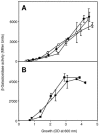Characterization of PhlG, a hydrolase that specifically degrades the antifungal compound 2,4-diacetylphloroglucinol in the biocontrol agent Pseudomonas fluorescens CHA0
- PMID: 16391073
- PMCID: PMC1352262
- DOI: 10.1128/AEM.72.1.418-427.2006
Characterization of PhlG, a hydrolase that specifically degrades the antifungal compound 2,4-diacetylphloroglucinol in the biocontrol agent Pseudomonas fluorescens CHA0
Abstract
The potent antimicrobial compound 2,4-diacetylphloroglucinol (DAPG) is a major determinant of biocontrol activity of plant-beneficial Pseudomonas fluorescens CHA0 against root diseases caused by fungal pathogens. The DAPG biosynthetic locus harbors the phlG gene, the function of which has not been elucidated thus far. The phlG gene is located upstream of the phlACBD biosynthetic operon, between the phlF and phlH genes which encode pathway-specific regulators. In this study, we assigned a function to PhlG as a hydrolase specifically degrades DAPG to equimolar amounts of mildly toxic monoacetylphloroglucinol (MAPG) and acetate. DAPG added to cultures of a DAPG-negative DeltaphlA mutant of strain CHA0 was completely degraded, and MAPG was temporarily accumulated. In contrast, DAPG was not degraded in cultures of a DeltaphlA DeltaphlG double mutant. To confirm the enzymatic nature of PhlG in vitro, the protein was histidine tagged, overexpressed in Escherichia coli, and purified by affinity chromatography. Purified PhlG had a molecular mass of about 40 kDa and catalyzed the degradation of DAPG to MAPG. The enzyme had a kcat of 33 s(-1) and a Km of 140 microM at 30 degrees C and pH 7. The PhlG enzyme did not degrade other compounds with structures similar to DAPG, such as MAPG and triacetylphloroglucinol, suggesting strict substrate specificity. Interestingly, PhlG activity was strongly reduced by pyoluteorin, a further antifungal compound produced by the bacterium. Expression of phlG was not influenced by the substrate DAPG or the degradation product MAPG but was subject to positive control by the GacS/GacA two-component system and to negative control by the pathway-specific regulators PhlF and PhlH.
Figures







Similar articles
-
Transcriptional Regulator PhlH Modulates 2,4-Diacetylphloroglucinol Biosynthesis in Response to the Biosynthetic Intermediate and End Product.Appl Environ Microbiol. 2017 Oct 17;83(21):e01419-17. doi: 10.1128/AEM.01419-17. Print 2017 Nov 1. Appl Environ Microbiol. 2017. PMID: 28821548 Free PMC article.
-
PhlG mediates the conversion of DAPG to MAPG in Pseudomonas fluorescens 2P24.Sci Rep. 2020 Mar 9;10(1):4296. doi: 10.1038/s41598-020-60555-9. Sci Rep. 2020. PMID: 32152338 Free PMC article.
-
Autoinduction of 2,4-diacetylphloroglucinol biosynthesis in the biocontrol agent Pseudomonas fluorescens CHA0 and repression by the bacterial metabolites salicylate and pyoluteorin.J Bacteriol. 2000 Mar;182(5):1215-25. doi: 10.1128/JB.182.5.1215-1225.2000. J Bacteriol. 2000. PMID: 10671440 Free PMC article.
-
Role of 2,4-diacetylphloroglucinol-producing fluorescent Pseudomonas spp. in the defense of plant roots.Plant Biol (Stuttg). 2007 Jan;9(1):4-20. doi: 10.1055/s-2006-924473. Epub 2006 Oct 23. Plant Biol (Stuttg). 2007. PMID: 17058178 Review.
-
Signal transduction in plant-beneficial rhizobacteria with biocontrol properties.Antonie Van Leeuwenhoek. 2002 Aug;81(1-4):385-95. doi: 10.1023/a:1020549019981. Antonie Van Leeuwenhoek. 2002. PMID: 12448737 Review.
Cited by
-
Sequential interspecies interactions affect production of antimicrobial secondary metabolites in Pseudomonas protegens DTU9.1.ISME J. 2022 Dec;16(12):2680-2690. doi: 10.1038/s41396-022-01322-8. Epub 2022 Sep 19. ISME J. 2022. PMID: 36123523 Free PMC article.
-
Regulatory roles of RpoS in the biosynthesis of antibiotics 2,4-diacetyphloroglucinol and pyoluteorin of Pseudomonas protegens FD6.Front Microbiol. 2022 Dec 8;13:993732. doi: 10.3389/fmicb.2022.993732. eCollection 2022. Front Microbiol. 2022. PMID: 36583049 Free PMC article.
-
Posttranscriptional regulation of 2,4-diacetylphloroglucinol production by GidA and TrmE in Pseudomonas fluorescens 2P24.Appl Environ Microbiol. 2014 Jul;80(13):3972-81. doi: 10.1128/AEM.00455-14. Epub 2014 Apr 18. Appl Environ Microbiol. 2014. PMID: 24747907 Free PMC article.
-
Transcriptional Regulator PhlH Modulates 2,4-Diacetylphloroglucinol Biosynthesis in Response to the Biosynthetic Intermediate and End Product.Appl Environ Microbiol. 2017 Oct 17;83(21):e01419-17. doi: 10.1128/AEM.01419-17. Print 2017 Nov 1. Appl Environ Microbiol. 2017. PMID: 28821548 Free PMC article.
-
New Insights into Pseudomonas spp.-Produced Antibiotics: Genetic Regulation of Biosynthesis and Implementation in Biotechnology.Antibiotics (Basel). 2024 Jun 27;13(7):597. doi: 10.3390/antibiotics13070597. Antibiotics (Basel). 2024. PMID: 39061279 Free PMC article. Review.
References
-
- Abbas, A., J. E. McGuire, D. Crowley, C. Baysse, M. Dow, and F. O'Gara. 2004. The putative permease PhlE of Pseudomonas fluorescens F113 has a role in 2,4-diacetylphloroglucinol resistance and in general stress tolerance. Microbiology 150:244-2450. - PubMed
-
- Baehler, E., M. Bottiglieri, M. Péchy-Tarr, M. Maurhofer, and C. Keel. 2005. Use of green fluorescent protein-based reporters to monitor balanced production of antifungal compounds in the biocontrol agent Pseudomonas fluorescens CHA0. J. Appl. Microbiol. 99:24-38. - PubMed
-
- Bao, Y., D. P. Lies, H. Fu, and G. P. Roberts. 1991. An improved Tn7-based system for the single-copy insertion of cloned genes into chromosomes of gram-negative bacteria. Gene 109:167-168. - PubMed
Publication types
MeSH terms
Substances
LinkOut - more resources
Full Text Sources
Other Literature Sources
Medical
Molecular Biology Databases

